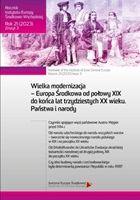Polskie kresy – bliskie i dalekie (1918-1939)
Polish Borderlands – Near and Far (1918-1939)
Author(s): Jarosław KłaczkowSubject(s): Diplomatic history, Political history, Social history, Geopolitics
Published by: Instytut Europy Środkowej
Keywords: Eastern Borderlands; Western Borderlands; Cieszyn Silesia; TransOlza;
Summary/Abstract: The subject of Borderlands situated further away and close by is presented not by accident. In the Polish historical narrative, we usually remember only about the Eastern Borderlands. Created by Henryk Sienkiewicz’s “Trilog”, known from the pages of Polish history, being a place of birth to Polish poets, they are inevitably memorable and integral part of Poland’s national tradition. This notion is so strong that the word ‘Borderlands’ is associated only with the formed eastern territories of Poland. We do not use this terminology for other areas. We think only of the eastern borderlands which were gradually lost between the 17th and 20th century. This article also mentions this fact. Nevertheless, the article presents a slightly different perspective, i.e. it tries to present the Borderlands that were distant because they were unknown or known very little, the Borderlands which did not manage to enter the Polish narratives and Polish historical memory for good. They entered Poland for a very short time and disappeared for it very quickly. Nowadays they are abroad and they are practically unknown. The distant, unknown former Polish western Borderlands was Trans-Olza (Zaolzie). The Silesian residents living there in the 19th century shaped mostly Polish national identity, i.e. at the time when the then modern European nations were establishing. Undoubtedly, this was influenced by a strong economic development of the territory of Cieszyn Silesia. On the one hand, it was a blessing, but on the other hand, it turned out to be its curse, causing the rivalry over this land between the Poles and Czechs. The conflict over this territory, where the ethnic issues played no significant role for the powers considering this matter. Moreover, it inscribed into different types of territorial conflicts that Europe experienced after the First World War. For the borders established by the victorious allied forces as part of the Versailles treaty were not entirely fair in any place, which, in turn, is an obvious matter because it is never possible to set borders that would fully satisfy all the parties of the conflict. This was also the case of the Polish-Czech conflict over Cieszyn Silesia. The rivalry did not cease with the borders being established by the allied forces in July 1920, and both countries were still interested in the population living there. The population faced assimilative activities as the so-called ‘Polonized Moravians’ by the Czechoslovakian Republic. On the other hand, this population became a causation for Poland when reclaiming this area in autumn 1938. In the second part of the article presents the realities of life in Trans-Olza in the second half of the 1930s, which were witnessed by Paweł Hulka-Laskowski. He collected material for his monumental work on Trans-Olza Silesia. This work is practically unknown today, but it is an equivalent of the results of Melchior Wańkowicz’s travels around East Prussia in the book Na tropach Smętka. Who has ever heard in Poland of the work by Paweł Hulka-Laskowski Śląsk za Olzą Similarly, who has the knowledge of the long-forgotten Western Borderlands? This article introduces readers to this subject matter.
Journal: Rocznik Instytutu Europy Środkowo-Wschodniej
- Issue Year: 21/2023
- Issue No: 3
- Page Range: 259-280
- Page Count: 22
- Language: Polish

